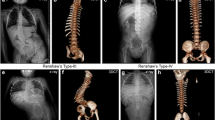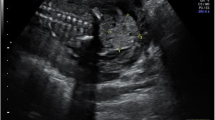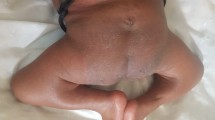Abstract
Background
Sacral agenesis is a rare neural tube defect characterized by abnormal development of the caudal aspect of the vertebral column and the spinal cord. Even though the etiology is unknown. Its pathophysiology has been linked to maternal diabetes, genetic factors, and several teratogens.
Case report
This case report presents the case of a young female patient (2 years old) of sacral agenesis type II with no neurogenic dysfunctions. MRI results were specifically used to make the diagnosis. There were no anatomical or functional impairments found in this patient, making the presentation of this case unique.
Conclusions
The case is being reported for its rarity and educational value because the prognosis is good in isolated sacral agenesis. Early detection and prompt treatment are crucial to decreasing the risk of complications and improving the prognosis.
Similar content being viewed by others
Avoid common mistakes on your manuscript.
Introduction
Sacral agenesis is a condition associated with caudal regression syndrome and is characterized by variable degrees of spinal column agenesis, along with lumbar and sacral abnormalities. It is a rare condition that affects 1 in 7500–100,000 newborns. In some affected individuals, it can appear as an isolated abnormal development of the sacrum; in others, it can be absent altogether. Sacral agenesis is also often seen to be present with narrowing of the hips; underdeveloped muscles of the buttocks, specifically hypoplastic gluteal muscles; a sacral dimple (an indentation on the skin of the lower back); and flattening of the buttocks. It can also be associated with other system abnormalities, including those of the central nervous, genitourinary, cardiac, respiratory, and gastrointestinal systems, with anorectal malformations being the most prevalent [1, 12, 15].
The exact cause of caudal regression syndrome is unknown. Most cases appear sporadically, which suggests environmental factors or a new gene mutation. According to researchers, the causes of sacral agenesis are multifactorial, including environmental, hereditary, and genetic factors. It is hypothesized that prenatal exposure to certain teratogenic chemicals (such as lithium and sulfamides) is a possible cause of the disruption of the development of the caudal section of the spine and spinal cord during the 28th gestational week, as well as diabetes in the mother [1, 2, 14]. Because of the high correlation between this defect and the diabetic mother and its development during the early stages of pregnancy, it is imperative to have a preventative strategy. Women with diabetes should have strict glycemic control, especially during the first few weeks of pregnancy. Prenatal ultrasounds, fetal MRIs, and prompt treatment can drastically improve the prognosis [3, 5].
Case report
A 2-year-old girl came to the outpatient department with a history of soft tissue lesions in her lower back area since birth. On inquiring, it was found that unawareness about the condition and financial uncertainty of the father were the main reasons for seeking medical attention belatedly. The girl was born full-term with a body weight of 2.5 kg through a spontaneous vaginal delivery at the hospital. According to the father, this lesion has been there since birth and is slowly growing. The father denies any episode of rapid growth during his daughter’s infancy period and refuses any history of bleeding, purulent, or fecal discharge from the soft tissue lesions. The baby has no other functional problems. She has attained her developmental milestones as per age and had her vaccinations completed per routine. Concerning her developmental milestones, she can walk and run without any concern. Although she is not toilet-trained yet, she has no any issues with bowel or bladder movements. The parents are consanguineous and otherwise in good health. The prenatal course of the mother is non-contributory, indicating that there were no known instances of exposure to potentially teratogenic toxins or drugs, including alcohol, during her pregnancy.
Additionally, there were no reports of fever or viral infections in the first trimester. This information is significant as exposure to harmful substances or infections during the early stages of pregnancy. It indicates that the mother has taken appropriate precautions and maintained a lifestyle that minimizes potential risks during this critical of fetal growth and organ formation peroid. She has two older siblings who are physically and mentally in good health. Parents denied any known history or known cases of congenital deformities in their family. They also denied past treatments for this lesion.
On examination, she was a 2-year-old baby girl with an age-appropriate weight and build. The anal opening, anal canal, and anal tone appear normal. There were no gross musculoskeletal deformities, including contractures, foot deformities, muscle weakness, asymmetries, or limb shortening, found on the thorough examination. There was no evidence of vertebral column deformities on inspection. However, a soft, cauliflower-shaped tissue lesion of about 4 × 10 cm was discovered in the sacrococcygeal region. The lesion has a smooth surface, normal skin tone, and convoluted skin folds with pits and pseudo-sinuses about three fingers wide posterior to the anal opening. It was noted that the skin surrounding the lesion had no changes or defects and seemed normal. The lesion was non-tender, soft in consistency, and compressible. It was non-reducible and had no palpable pulsations or phleboliths. The fold was gliding on itself; only the central part of the skin was adherent to the underlying tissue. The trans-illumination test was non-contributory. There were no clinical signs of lipoma (see Fig. 1).
After a detailed history and comprehensive examination, vascular malformations, degenerative nerve tissue, and teratomas, along with their variations, were considered differential diagnoses. A plain pelvic X-ray and a Doppler ultrasound (US) were ordered. The patient did not return for six months after that. They later returned without the X-ray films. They had lost the X-ray film and report while consulting many general practitioners for a second opinion. Following that, the case was discussed by the multidisciplinary team (pediatrician, neurosurgeon, radiologist, plastic surgeon, and pediatric surgeon), and they decided not to repeat the X-ray to protect the patient from radiation exposure and financial hardship. For a definitive diagnosis and to investigate any related pelvic pathology, an MRI (magnetic resonance imaging) was ordered.
Ultrasound report findings
An ultrasound was requested to rule out other anomalies and malformations. On a high-frequency transducer, a hypoechoic oval-shaped area with skin folds is noted within the subcutaneous area of the sacrococcygeal region and measures about 34.0 × 10.0 mm. No vascularity is seen on the color Doppler. There was no evidence of sinus fistulous tract communication, myelocyte, meningomyelocele, or sacrococcygeal teratoma. Adv: MRI for further workup.
MRI report findings
An MRI lumbosacral without contrast was performed with T1 and T2 axial and sagittal images to confirm the diagnosis (see Figs. 2, 3, 4, and 5). It showed that the lower sacral segments were completely absent, the S2 vertebra was only partially present, and the S1 vertebra was normal and articulating with both iliac bones. The distal spinal cord was normal and lacked any specific abnormalities or morphological changes. There was no sign of the cord being tethered. Moreover, there were no vascular malformations noticed, and no myelomeningocele was present. The overlying skin was intact and loosely packed. Furthermore, the rectosigmoid colon was bulging or herniating posteriorly through the defective lower sacral segments.
Operative findings
A posterior midline incision was made by the neurosurgeon, and skin flaps were raised. The centrally tethered skin area was released from the underlying structures. The skin was freed on both sides of the incision, cranially and caudally. The operative field looked for any areas of degenerative nerve tissue, dural damage, or CSF (cerebrospinal fluid) leakage that needed to be repaired immediately. After securing hemostasis, the wound was planned to be closed primarily by the plastic surgeon. Due to precautionary measures, the incision was not extended caudally towards the anal opening. All the remaining poor-quality skin had been excised, and the wound was closed with a vertical mattress. The procedure went off without a hitch or negative outcomes. The patient recovered without any difficulty. The histopathology of the resected skin reveals benign connective tissue composed of stratified squamous epithelium with lymphocytic infiltrate. Underlying adipose tissue and hyperkeratosis are noted. The core of vascular tissue and sweat glands is also seen. The surgical wound was successfully healed without any issues. The patient is doing well at her 8-month post-surgery follow-up visit. She is now being toilet trained. The mother denied any incontinence or chronic constipation episodes. She also has bladder control during the day.
Discussion
Sacral agenesis is a rare congenital malformation, with the assumption being that it is multifactorial. It can happen alone or in conjunction with caudal regression syndrome. There is a high correlation between this defect and diabetes, and pregnant women with diabetes should have strict glycemic control, especially during the first few weeks of pregnancy. Further, prenatal ultrasounds, fetal MRIs, and prompt treatment can drastically improve the prognosis.
According to recent literature, such structural abnormalities can result from perturbations of mesodermal specification, epithelial-mesenchymal transition, and mesodermal cell migration [6]. Sacral agenesis could be passed down either as a dominant or recessive trait. The HLXB9 gene, located at 7q36, causes birth abnormalities and is associated with the condition, which results in the dominantly inherited sacral agenesis known as Currarino syndrome [9, 10]. A correlation with Currarino syndrome is strongly suspected: thus, gene testing is recommended. Although gene testing is advised, parents declined to consent for further investigation after counselling. Sacral agenesis does not always refer to caudal regression syndrome, though. While sacral agenesis is a radiological result, caudal regression syndrome is a clinical condition. According to the degree of sacral dysgenesis and the articulation between the spine and pelvis, sacral agenesis is classified into four types:
-
Type I: Unilateral agenesis localized to the sacrum or coccyx.
-
Type II: Partial agenesis with bilateral defects, the iliac bone articulates with S1, but the distal sacral elements fail to develop.
-
Type III: Total sacral agenesis, iliac bones articulate with the lowest lumbar element.
-
Type IV: Total sacral agenesis, iliac bones fuse posteriorly [11, 13].
Our patient is classified as category II by the Renshaw system. This group has an even poorer prognosis than the previous one, with more severe multisystemic sequelae, especially at the renal level, and a bigger neurological impact [4]. However, in this case, the soft tissue mass in the presacral region was all that was present clinically, with no additional structural or physiological abnormalities [2, 7, 8]. Treatment is challenging for all types of sacral agenesis. It demands a multidisciplinary approach involving a pediatrician, a pediatric surgeon, an orthopedic surgeon, a neurosurgeon, and a urologist, depending on the severity and clinical presentation. The treatment is mainly surgical for our patients. The abnormalities that require special attention are bladder and bowel incontinence, orthopedic deformities, and renal dysfunction, which were not present in this patient. Hence, the case was managed with a single surgical intervention. The patient remains in follow-up with plastic surgery, neurology, and general pediatrics to keep a close watch on all the risk factors and possible complications.
Conclusion
The diagnosis of sacral agenesis is often overlooked when there are no other malformations associated with it. Regardless of stage, it is crucial to explore and diagnose sacral agenesis to provide the appropriate management. The type of sacral agenesis categorized by the affected spine and spinal cord determines the management. A multidisciplinary follow-up is required to watch for any potential complications. We reported a case of sacral agenesis with normal renal and neurologic function and a lack of gross anomalies or developmental delay in any domain. Although good survival is predicted without any complications, it is advisable to conduct routine urologic, renal, and UTI screenings to monitor for potential complications.
Primary takeaway
-
Sacral agenesis is a part of caudal regression syndrome, is a rare congenital condition that affects 1 in 7500–100,000 newborns, and is characterized by variable degrees of spinal column agenesis.
-
The exact etiology of the disease is not known yet, but maternal diabetes mellitus has been found to have an association.
-
Prenatal ultrasonography could play a vital role in diagnosing the condition, but it is often overlooked due to the rarity of the disease.
-
When no additional anomalies are present, the diagnosis of sacral agenesis is frequently missed. Regardless of stage, it is crucial to explore and diagnose sacral agenesis to provide appropriate and timely management.
Availability of data and materials
Not applicable
References
Balioğlu MB, Akman YE, Ucpunar H, Albayrak A, Kargın D, Atıcı Y, Büyük AF. Sacral agenesis: evaluation of accompanying pathologies in 38 cases, with analysis of long-term outcomes. Childs Nerv Syst. 2016;32(9):1693–702.
Dewberry L, Peña A, Mirsky D, Ketzer J, Bischoff A. Sacral agenesis and fecal incontinence: how to increase the index of suspicion. Pediatr Surg Int. 2019;35:239–42.
Dworschak GC, Reutter HM, Ludwig M. Currarino syndrome: a comprehensive genetic review of a rare congenital disorder. Orphanet Journal of Rare Diseases. 2021;16(1):167. https://doi.org/10.1186/s13023-021-01799-0.
Fahmy MAB. Caudal Regression Syndrome and Sacral Agenesis. In: Rare Congenital Genitourinary Anomalies. Springer, Berlin, Heidelberg; 2015. p. 231–5. https://link.springer.com/chapter/10.1007/978-3-662-43680-6_15.
Gotoh T, Shinno Y, Kobayashi S, Watarai Y, Koyanagi T. Diagnosis and management of sacral agenesis. European urology. 1991;20(4):287–92.
Kumar Y, Gupta N, Hooda K, Sharma P, Sharma S, Kochar P, Hayashi D. Caudal regression syndrome: a case series of a rare congenital anomaly. Pol J Radiol. 2017;82:188–92.
Lynch SA, Wang Y, Strachan T, Burn J, Lindsay S. Autosomal dominant sacral agenesis: Currarino syndrome. J Medic Genet. 2000;37(8):561–6.
Martucciello G, Torre M, Belloni E, Lerone M, Prato AP, Cama A, Jasonni V. Currarino syndrome: proposal of a diagnostic and therapeutic protocol. J Pediatr Surg. 2004;39(9):1305–11.
Mehdi SM, Baig U, Zia MH, Iftikhar N. Caudal regression syndrome—a rare congenital disorder: a case report. J Pak Med Assoc. 2021;71(12):2847–9.
Mottet N, Martinovic J, Baeza C, Guimiot F, Bault J-P, Aubry MC, Benachi A. Think of the conus medullaris at the time of diagnosis of fetal sacral agenesis. Fetal Diagn Ther. 2017;42(2):137–43.
Renshaw TS. Sacral agenesis. J Bone Joint Surg Am. 1978;60(3):373–83.
Sarnat HB, CASE, M. E., & GRAVISS, R. Sacral agenesis: neurologic and neuropathologic features. Neurology. 1976;26(12):1124–1124.
Sharma S, Sharma V, Awasthi B, Sehgal M, Singla DA. Sacral agenesis with neurogenic bladder dysfunction—a case report and review of the literature. J Clin Diagn Res. 2015;9(6):RD08-9.
Wilmshurst JM, Kelly R, Borzyskowski M. Presentation and outcome of sacral agenesis: 20 years’ experience. Developmental Medicine & Child Neurology. 1999;41(12):806–12.
Zhang Y, Sun C, Jiang C, Zhao W, Wang W, Cao Q, Ge S. Prenatal diagnosis of caudal regression with heterotaxy syndrome:“a mermaid with a broken heart.” Echocardiography. 2019;36(2):415–8.
Acknowledgements
The authors gratefully acknowledge Dr. Murli Manohar, Assistant Professor of Radiology at Bilawal Medical College for Boys and Liaquat University of Medical and Health Sciences, Jamshoro, Pakistan, for his kind assistance in the selection and reporting of MRI images. The authors extend their profound gratitude to Dr. Sara Kazmi Chief Resident Radiology, Dow Institute of Radiology, Ojha Campus, Dow Hospital, Karachi, for her assistance in review of scans of this case report and Dr. Anum Sheikh Pathologist for her kind support and reporting of samples free of cost.
Funding
The authors did not receive support from any organization for the submitted work.
Author information
Authors and Affiliations
Contributions
Both authors contributed equally to the study’s conception, design, and writing. Material preparation, data collection, and analysis were performed by ZK and MS. The first draft of the manuscript was written by MS and ZK, and later, both authors edited it multiple times before approving the final manuscript.
Corresponding author
Ethics declarations
Ethics approval and consent to participate
The Ethics Review Committee of Indus Medical College has waived this case study from ethical approval.
Consent for publication
Written informed consent for publication of the participant’s clinical details and clinical images was obtained from patient's parent.
Competing interests
The authors declare that they have no competing interests.
Additional information
Publisher’s Note
Springer Nature remains neutral with regard to jurisdictional claims in published maps and institutional affiliations.
Rights and permissions
Open Access This article is licensed under a Creative Commons Attribution 4.0 International License, which permits use, sharing, adaptation, distribution and reproduction in any medium or format, as long as you give appropriate credit to the original author(s) and the source, provide a link to the Creative Commons licence, and indicate if changes were made. The images or other third party material in this article are included in the article's Creative Commons licence, unless indicated otherwise in a credit line to the material. If material is not included in the article's Creative Commons licence and your intended use is not permitted by statutory regulation or exceeds the permitted use, you will need to obtain permission directly from the copyright holder. To view a copy of this licence, visit http://creativecommons.org/licenses/by/4.0/.
About this article
Cite this article
Khan, Z., Saleem, M. Brief title of the study case report: a case of type II sacral agenesis with no neurogenic dysfunction. J Rare Dis 3, 11 (2024). https://doi.org/10.1007/s44162-024-00035-0
Received:
Accepted:
Published:
DOI: https://doi.org/10.1007/s44162-024-00035-0









